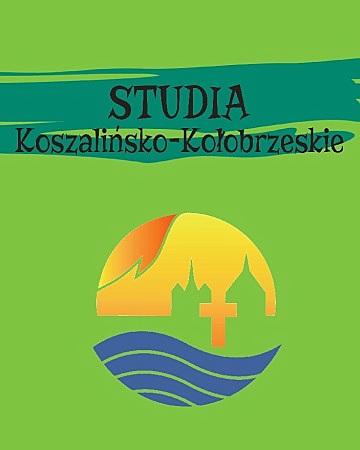
ISSN: 1230-0780
eISSN: 2719-4337
OAI
DOI: 10.18276/skk.2020.27-03





Lista wydań /
nr 27 2020
Czy wędrówka Teracha z Ur do Charanu posiada elementy lunarne? Analiza egzegetyczna Rdz 11,27–32
| Autorzy: |
Andrzej Ł.
Jędrzejczak

doktorant Wydziału Teologicznego Uniwersytetu im. Adama Mickiewicza w Poznaniu |
| Słowa kluczowe: | Terach Księga Rodzaju wędrówka Ur Charan kulty lunarne motywy lunarne |
| Data publikacji całości: | 2020 |
| Liczba stron: | 16 (49-64) |
Abstrakt
Zainteresowanie wędrówką Teracha z Ur do Charanu wiąże się z próbą wskazania elementów lunarnych, jakie mogą występować w tekście Rdz 11,27–32. Izrael nie był hermetycznie zamkniętą wspólnotą i wiele elementów znanych z systemów religijnych starożytnego Bliskiego Wschodu przeniknęło do tekstów biblijnych. Opracowanie ma na celu ukazanie tych elementów z historii wędrówki Teracha, które mogą potwierdzać lub przeczyć wpływom kultów lunarnych na tekst z Księgi Rodzaju.
Pobierz plik
Plik artykułu
Bibliografia
| 1. | Arnold, Bill Terence. „Aramean Origins: The Evidence from Babylonia”. Archiv für Orientforschung 52 (2011): 179–185. |
| 2. | Beaulieu, Paul-Alain. „Nabonidus the Mad King: A Reconsideration of His Steles from Harran and Babylon”. W: Representations of Political Power. Case Histories from Times of Change and Dissolving Order in the Ancient Near East, red. Marlies Heinz, Marian H. Feldman, 137–168. Winona Lake: Eisenbrauns, 2007. |
| 3. | Black, Jeremy, Andrew George, Nicholas Postgate, red. A Concise Dictionary of Akkadian, Wiesbaden: Harrassowitz Verlag, 2000. |
| 4. | Blenkinsopp, Joseph. „Abraham as Paradigm in the Priestly History in Genesis”. Journal of Biblical Literature 2 (2009): 225–241. |
| 5. | Clines, David J.A. The Dictionary of Classical Hebrew. T. 2. Sheffield: Sheffield Academic Press, 1995. |
| 6. | Crawford, Harriet. Ur. The City of the Moon God. London: Bloomsbury, 2015. |
| 7. | Del Olmo Lete, Gregorio, Joaquin Sanmartin, red. A Dictionary of the Ugaritic Language in the Alphabetic Tradition. T. 1. Leiden: Brill, 2003. |
| 8. | Finkelstein, Israel. „Patriarchs, Exodus, Conquest: Fact or Fiction?”. W: The Quest for the Historical Debating Archaeology and the History of Early Israel, red. Brian B. Schmidt, 41–56. Leiden: Brill, 2007. |
| 9. | Garret, Duane A. Amos. A Handbook on the Hebrew Text. Waco: Baylor University Press, 2008. |
| 10. | Gordon, Cyrus Herzl. „The Road to Emar”. Journal of Cuneiform Studies 18 (1964): 57–88. |
| 11. | Green, Tamara M. The City of the Moon God. Religious Traditions of Harran. Religions in the Graeco-Roman World 114. Leiden: Brill, 1992. |
| 12. | Guillaume, Philippe. Land and Calendar. The Priestly Document from Genesis 1 to Joshua 18. Library of Hebrew Bible/Old Testament Studies 391. New York: T&T Clark, 2009. |
| 13. | Gunkel, Hermann. The Legends of Genesis: The Biblical Saga and History. Chicago: The Open Cort Publishing Co., 1901. |
| 14. | Hendel, Ronald, „Historical Context”. W: The Book of Genesis. Composition, Reception, and Interpretation, red. Craig A. Evans, Joel N. Lohr, David L. Petersem, 51–83. Supplement to Vetus Testamentum 152. Leiden: Brill, 2012. |
| 15. | Huddlestone, Jeremy. Eschatology in Genesis. Tübingen: Mohr Siebeck, 2012. |
| 16. | Hughes, Jeremy. Secrets of the Myth. Myth and History in Biblical Chronology. Journal for the Study of the Old Testament Supplement Series 66. Sheffield: JSOT Press, 1990. |
| 17. | Klein, Reuven Chaim. „Nahmanides’ Understanding of Abraham’s Mesopotamian Origins”. Jewish Bible Quarterly 44 (2016): 233–240. |
| 18. | Krachamlkov, Charles R. Phoenician-Punic Dictionary. Orientalia Lovaniensia Analecta 90. Leuven: Peeters, 2000. |
| 19. | Majewski, Marcin. Pięcioksiąg odczytany na nowo. Przesłanie autora kapłańskiego (P) i jego wpływ na powstanie Pięcioksięgu. Kraków: Wydawnictwo Naukowe UP JPII, 2018. |
| 20. | Mazar, Amihai. Archaeology of the Land of the Bible 10,000–568 B.C.E. New York: Doubleday, 1990. |
| 21. | Moriconi, Alessandro. „Rising Moon at Tell eš-Ŝerīʿa/Tel Sera: A Neo-Assyrian Bronze Crescent Standard and The Iconography of the Moon God Sȋn of Ḫarrān in Southern Levant. Ritual Paraphenalia and Military Insignia?”. Ägypten und Levante / Egypt and the Levant 28 (2018): 409–418. |
| 22. | Roux, Georges. Mezopotamia. Warszawa: Dialog, 2018. |
| 23. | Römer, Thomas. „Abraham Traditions in the Hebrew Bible Outside the Book of Genesis”. W: The Book of Genesis. Composition, Reception, and Interpretation, red. Craig A. Evans, Joel N. Lohr, David L. Petersen, 159–180. Supplement to Vetus Testamentum 152. Leiden: Brill, 2012. |
| 24. | Smith, Mark S. The Early History of God. Yahweh and the Others Deities in Ancient Izrael. Grand Rapids: Eerdmans, 2002. |
| 25. | Speiser, Ephraim Avigdor. Genesis. Introduction, Translation, and Notes. The Anchor Bible 1. New York: Doubleday, 1964. |
| 26. | Stavrakopolou, Francesca. Land or Our Fathers. The Roles of Ancestor Veneration in Biblical Land Claims. Library of Hebrew Bible/Old Testament Studies 473. New York: T&T Clark, 2010. |
| 27. | Steinberg, Naomi A. „The World of the Family in Genesis”. W: The Book of Genesis. Composition, Reception, and Interpretation, red. Craig A. Evans, Joel N. Lohr, David L. Petersem, 279–302. Supplement to Vetus Testamentum 152. Leiden: Brill, 2012. |
| 28. | Taylor, Glen J. Yahweh and the Sun. Biblical and Archeological Evidence for Sun Worship in Ancient Israel. Journal for the Study of the Old Testament Supplement Series 111. Sheffield: JSOT Press, 1993. |
| 29. | Thompson, Thomas L. The Historicity of the Patriarchal Narrative. The Quest for the Historical Abraham. Beiheft zur Zeitschrift für die alttestamentliche Wissenschaft 133. Berlin: Walter de Gruyter, 1974. |
| 30. | Wolters, Al. „Belshazzar’s Feast and the Cult of the Moon God Sȋn”. Bulletin for Biblical Research 5 (1996): 199–206. |